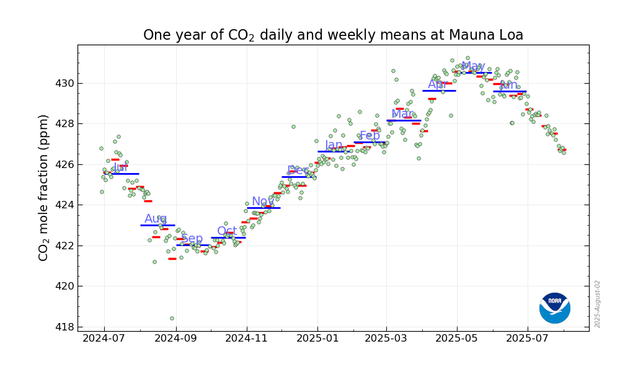Monthly mean carbon dioxide as measured at Mauna Loa Observatory, Hawaii.
July 2025:
427.87. ppm
July 2024:
425.55 ppm
The carbon dioxide data on Mauna Loa constitute the longest record of direct measurements of CO2 in the atmosphere.
https://gml.noaa.gov/ccgg/trends/
Laboratory Modeling of Supernova Remnants Collisions: Implications for Triggered Star Formation
Marin Fontaine, Clotilde Busschaert, \'Emeric Falize
https://arxiv.org/abs/2508.05151
The July average of atmospheric CO₂ at Mauna Loa was ~2.3-2.4 ppm higher than last year: based on daily values, it was around 427.9 ppm.
#co2
Doppler shifted Hawking radiation from acoustic black holes in ultra-relativistic heavy-ion collisions
Sanatan Digal, Ajit M. Srivastava
https://arxiv.org/abs/2509.02079 https:/…
AI-driven neutrino diagnostics and radiation-hard beam instrumentation for next-generation neutrino experiments
S. Ganguly (Fermi National Accelerator Laboratory)
https://arxiv.org/abs/2508.06645
Modelling Tritium Production and Release at High-Energy Proton Accelerators
Dali Georgobiani (Fermi National Accelerator Laboratory), Thomas Ginter (Michigan State University), Alajos Makovec (Fermi National Accelerator Laboratory), Igor Rakhno (Fermi National Accelerator Laboratory), Matthew Strait (Fermi National Accelerator Laboratory), Igor Tropin (Fermi National Accelerator Laboratory)

Modelling Tritium Production and Release at High-Energy Proton Accelerators
Tritium is a well-known byproduct of particle accelerator operations. To keep levels of tritium below regulatory limits, tritium production is actively monitored and managed at Fermilab. We plan to study tritium production in the targets, beamline components, and shielding elements of the Fermilab facilities such as NuMI, BNB, and MI-65. To facilitate the analysis, we construct a simple model and use three Monte Carlo radiation codes, FLUKA, MARS, and PHITS, to estimate the amount of tritium pr…








